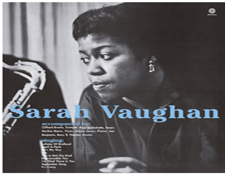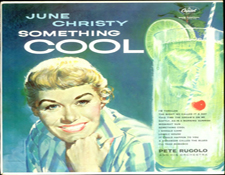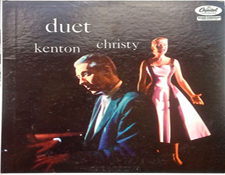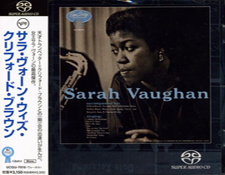It’s the time of year for saving money!
 When it comes to jazz, I am a bit picky about the Female singers I enjoy listening to. For me to really get into what they are doing, there has to be a certain inexplicable “something” that separates the — if you will — girls from the women. Growing up with two older brothers and parents who liked music a lot, I was exposed to a lot of different styles, from big band to sappy pop to folk to electric blues and early heavy metal and beyond. My middle brother was the first to get deep into jazz and through him I gained an appreciation for the swing factor in music and the spaces between the notes. I also gained an appreciation for the bluesy side of jazz and the ability for some musicians to convey a sense of sadness as much as elation within their sound, sometimes in the same breath. The first jazz I really connected with was probably John Coltrane followed shortly thereafter by Chick Corea’s Return to Forever and John McClaughlin’s Mahavishnu Orchestra and then Charles Mingus.
When it comes to jazz, I am a bit picky about the Female singers I enjoy listening to. For me to really get into what they are doing, there has to be a certain inexplicable “something” that separates the — if you will — girls from the women. Growing up with two older brothers and parents who liked music a lot, I was exposed to a lot of different styles, from big band to sappy pop to folk to electric blues and early heavy metal and beyond. My middle brother was the first to get deep into jazz and through him I gained an appreciation for the swing factor in music and the spaces between the notes. I also gained an appreciation for the bluesy side of jazz and the ability for some musicians to convey a sense of sadness as much as elation within their sound, sometimes in the same breath. The first jazz I really connected with was probably John Coltrane followed shortly thereafter by Chick Corea’s Return to Forever and John McClaughlin’s Mahavishnu Orchestra and then Charles Mingus.
I had heard some jazz singers by that point but it wasn’t until I found a copy of a 1954 Sarah Vaughan album at a garage sale that made me really listen to the voice as a jazz instrument. To this day, Sarah is my benchmark for all other jazz singers I listen to.
Sure, Ella Fitzgerald has incredible technique and Billie Holiday basically invented the form, the latter even giving tips to a young Sarah Vaughan along the way. For me, it was in fact Sarah who I felt captured — and delivered — the essence jazz singing at its most pure, bringing a street sensibility to her delivery that lets her swing and dance around the the rhythms and notes. Even when she was singing her poppiest material — and for much of her prime period in the 1950s there was a division in her recorded output, with pop songs released on the Mercury label while more pure jazz releases were put out on the EmArcy subsidiary — there was a sense of passion in her delivery, that sense of the artist being inside the song. It was that special something kept me listening and wanting to hear everything she every recorded.
 Lately I have been revisiting some records that have crept into my collection and decided some are not worthy of the space they are consuming. For example, I several years ago I started picking up albums by Chris Connor, a singer that came out of Stan Kenton’s big band; clearly her albums were reissued on CD and thus old LPs were less of interest to some fans who were trading them in. Before I knew it, I had five or six Chris Connor’s albums taking up a chunk of precious shelf space in my collection. After giving these bargain finds some time and numerous listens I have decided to pretty much purge my collection of her albums. They are ok, but she Connors seems to sleepwalk through the music without delivering any real sense of commitment.
Lately I have been revisiting some records that have crept into my collection and decided some are not worthy of the space they are consuming. For example, I several years ago I started picking up albums by Chris Connor, a singer that came out of Stan Kenton’s big band; clearly her albums were reissued on CD and thus old LPs were less of interest to some fans who were trading them in. Before I knew it, I had five or six Chris Connor’s albums taking up a chunk of precious shelf space in my collection. After giving these bargain finds some time and numerous listens I have decided to pretty much purge my collection of her albums. They are ok, but she Connors seems to sleepwalk through the music without delivering any real sense of commitment.
In comparison, consider her predecessor in the Kenton band was June Christy. Like Connors, Christy was a blonde who looked more like a Wonderbread mom than a jazz singer. However, I never judge a blonde by her cover (if you’ll pardon the admittedly cheap cliche), because Christy could swing like mad, earning her the respect of her musician contemporaries and a very committed record company, Capitol. Look on YouTube for the video of her with Nat King Cole and Mel Torme — on drums! — for an idea of what I’m talking about. June Christy finds the heart of the song, even when tacking sugary pop.
I first discovered her about five or so years ago when Collectors Choice Music ran ads for a reissue of her first solo recording, Something Cool (from 1954 & ’55, recorded in Mono). The reissue was paired with a 1960 re-recording of the exact same album with (pretty much) the same band and arranger backing her up, only issued in stereo. Curious that an artist I’d never heard of could command such unusual treatment (and respect, frankly) from her label, I ordered the CD reissue. It proved to be every bit the revelation the ad promised with two very distinct takes on the same music — a younger Christy shooting more from the hip on the earlier version and taking a more mature approach to it in the later years. Interestingly, the only way to distinguish the early and later editions was through the cover art, the later editions appearing in a more full color cover, using similar but decidedly different artwork.
 My interest in Christy blossomed further when a friend gave me a stack of her grandmother’s old LPs and in the pile of moldy dusty discs was Duets, a 1955 reunion album pairing Christy with her former bandleader (and, I suspect, one-time romantic interest), Stan Kenton. Made with (at best) two microphones, Duets is a stunning recording of raw solo piano and pure voice. The takes are so intimate and under produced, it feels like you are a fly on a wall listening to a casual reunion of the two sitting side by side in front of the piano after meeting up for cocktails. Its almost as if the session was not meant to be recorded yet you are glad it was! A curious tension fills the air as they tackle songs like “Lonely Woman,” “You’re Mine You!,” “Ev’ry Time We Say Goodbye” and “We Kiss In a Shadow.” I eventually picked up a CD reissue of this collection as it has some bonus tracks but there is no doubt in my mind that the original mono LP is the best way to really experience this music.
My interest in Christy blossomed further when a friend gave me a stack of her grandmother’s old LPs and in the pile of moldy dusty discs was Duets, a 1955 reunion album pairing Christy with her former bandleader (and, I suspect, one-time romantic interest), Stan Kenton. Made with (at best) two microphones, Duets is a stunning recording of raw solo piano and pure voice. The takes are so intimate and under produced, it feels like you are a fly on a wall listening to a casual reunion of the two sitting side by side in front of the piano after meeting up for cocktails. Its almost as if the session was not meant to be recorded yet you are glad it was! A curious tension fills the air as they tackle songs like “Lonely Woman,” “You’re Mine You!,” “Ev’ry Time We Say Goodbye” and “We Kiss In a Shadow.” I eventually picked up a CD reissue of this collection as it has some bonus tracks but there is no doubt in my mind that the original mono LP is the best way to really experience this music.
 Going back to Sarah Vaughan, I am going to go out on a limb and recommend a SACD of my favorite recordings by her, without even having heard that version! I do however know just how great that album is — it is that first listen to Sarah Vaughan’s voice which captivated and sealed me in as a fan for life. If you can’t find the SACD, there seems to be an LP reissue on the Speakers Corner label; I haven’t heard it ether but given the label’s reputation, its probably the next best thing to finding a clean original LP (which is what I have). This record features a wonderful, close-knit and warmly recorded small group featuring some of the greatest players of the period including Clifford Brown on trumpet, Paul Quinchette on saxophone, Herbie Mann on flute and Roy Haynes on drums. Her interpretations of “Lullabye of Birdland,” “April in Paris,” “Jim” and “September Song” are just spectacular — beginning to end, the album is just perfect. Do look for her collection from around that same period called “In The Land of HiFi,” also on EmArcy Records. Primo stuff!
Going back to Sarah Vaughan, I am going to go out on a limb and recommend a SACD of my favorite recordings by her, without even having heard that version! I do however know just how great that album is — it is that first listen to Sarah Vaughan’s voice which captivated and sealed me in as a fan for life. If you can’t find the SACD, there seems to be an LP reissue on the Speakers Corner label; I haven’t heard it ether but given the label’s reputation, its probably the next best thing to finding a clean original LP (which is what I have). This record features a wonderful, close-knit and warmly recorded small group featuring some of the greatest players of the period including Clifford Brown on trumpet, Paul Quinchette on saxophone, Herbie Mann on flute and Roy Haynes on drums. Her interpretations of “Lullabye of Birdland,” “April in Paris,” “Jim” and “September Song” are just spectacular — beginning to end, the album is just perfect. Do look for her collection from around that same period called “In The Land of HiFi,” also on EmArcy Records. Primo stuff!
There are other modern singers I love too… Patti Cathcart of Tuck and Patti fame is brilliant and you can’t really go wrong with any of their albums (don’t be thrown by the Windham Hill label — these are beautifully made jazz recordings). I like what I have heard from Cassandra Wilson as well. I have enjoyed some of Rickie Lee Jones’ jazzier albums in recent years as well.
Do you have any Female Jazz singers you recommend highly? Let us know!
Mark Smotroff is a freelance writer and avid music collector who has worked for many years in marketing communications for the consumer electronics, pro audio and video games industries, serving clients including DTS, Sega, Sony, Sharp, AT&T and many others. www.smotroff.com Mark has written for EQ Magazine, Mix Magazine, Goldmine/DISCoveries Magazine, BigPictureBigSound.com, Sound+Vision Magazine and HomeTechTell.com. He is also a musician / composer whose songs have been used in TV shows such as Smallville and Men In Trees as well as films and documentaries. www.ingdom.com Mark is currently rolling out a new musical he’s written: www.dialthemusical.com.






